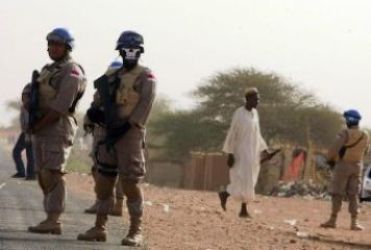Security Council heads towards reduction of Darfur hybrid force
April 26, 2012 (KHARTOUM) – U.N. undersecretary-general Herve Ladsous recommended Thursday to reduce some 4000 troops of the African Union –United Nations Mission in Darfur (UNAMID) as result of the improvement of security situation there.

UNAMID chief Ibrahim Gambari reaffirmed on 12 April in a press conference held in Khartoum the decrease of fighting between the government and rebel groups. He also mentioned the reduction of criminal activities and banditry, , hijacking and kidnapping.
In a briefing to the UN Sceurity Council, Ladsous said that troops should be cut by 3,260 of the 18081 deployed military troops , and police should be reduced by 770 of the 6,432 police.
“The proposed reduction in infantry is due mainly to improvements in security along the Chad-Darfur border and far northern Darfur following rapprochements between Sudan and Chad and between Sudan and Libya,” Ladsous said.
He further said a half of the infantry companies will be redeployed in East and South Darfur states which witnesses an increase of attacks carried out by rebel groups who cross from South Sudan.
Last week the Central African Republic (CAR) said that Darfur rebels killed 11 of its soldiers saying the assailants wanted to steal weapons and ammunition.
The rebel Sudan Liberation Movement of Minni Minnawi, on 19 April said they attacked Sudanese troops in South Darfur area of Umm Dafog bordering the CAR.
Speaking to the media after the UN Security council meeting, Sudanese ambassador to the United Nations, Daffa-Alla Elhag Ali Osman said “very happy” and “very satisfied” of Ladsous proposal to downsize the UNAMID forces.
He stressed that this move “reflects the peace process which came as a result of the engagement of the government of Sudan with those who signed the Doha agreement.”
He also regretted that the president of the Council, US ambassador Suzan Rice did not underline in its briefing to the press the growing instability in Darfur areas near South Sudan border.
He added that this situation is caused by rebel groups who used to cross the border from Raja in South Sudan where they are based. He went further to repeat the accusations of his government against Juba of supporting and harbouring rebels.
Ambassador Rice who chairs the Council for April said the UN peacekeeping department in its proposal about the reduction of UNAMID intends to make “a right-sizing” and not a downsizing its forces.
“From the U.S. point of view we’re hardly sanguine about the security situation, we see that the violence is escalating in four or five regions of Darfur … . This remains a very insecure, very serious situation,” Rice said.
Sudan since last year asked to cut the UNAMID forces after the signing of the Doha Document for Peace in Darfur with the former rebel Liberation and Justice Movement (LJM) on 14 July 2011.
A tripartite committee composed of Sudan, African Union and United Nations held different meetings to consider the demand and make proposals to the UN Security Council. The last meeting in this regard was held in Addis Ababa last March.
Different reports underline the improvement of security situation as the rebel groups moved many of their combatants to South Kordofan where they are fighting Khartoum’s army besides the Sudan People’s Liberation Movement – North (SPLM-N).
Since last November, three key rebel groups and the SPLM-N formed an alliance called Sudan Revolutionary Front aiming to topple the regime in Khartoum.
(ST)
